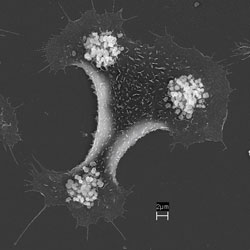Waiting for the right moment

Neisseria gonorrhoeae bacteria, forming micro-colonies on the surface of a human cell, stimulate signals to stabilize their extracellular life style. Image: Max Planck Institute for Infection Biology<br>
Pathogens make themselves feel at home in the human body, invading cells and living off the plentiful amenities on offer. However, researchers at the Max Planck Institute for Infection Biology, Berlin, together with colleagues at Harvard University, reveal an opposite strategy used to ensure infection success. Pathogens can actually delay their entry into cells to ensure their survival. Upon cell contact, bacteria trigger a local strengthening of the cellular skeleton with the aid of signalling molecules, allowing them to remain outside the cell. The researchers also show that this strategy, unknown until now, is used by certain intestinal pathogens as well. (PLoS Biology, 24th of August 2010)
Infection with the sexually transmitted bacterium Neisseria gonorrhoeae can lead to an inflammation of the urogenital tract, the uterus and ovaries. By means of thread-shaped proteins on its surface called pili, the bacterium attaches itself to the cell membrane. Once attached, the bacteria undergo rapid changes of their surface structure to avoid recognition by the host’s immune system. Only during the later stages of infection will the pathogens penetrate cells and occasionally advance into deeper tissues to find further breeding ground.
Until now scientists were firmly focused on understanding the tricks used by these pathogens to enter cells. The results of the Berlin-based researchers suggest, however, that bacteria may spend as much effort in resisting cell entry. Host cells tend to generate tiny vesicles by which they transport bacteria inadvertently into the interior. The researchers have now shed some light on the signals which prevent the bacteria from being ‘swallowed’. Upon fastening themselves to the cell surface, the bacteria induce a sequence of events that results in the strengthening of the cell skeleton directly beneath the point of attachment. The structural protein Actin is transported to attachment sites, where it forms a strong, supportive chain. In tandem, another structural protein Caveolin-1 and the signalling proteins VAV2 and RhoA are recruited to the cell membrane where they play a central role in effectively maintaining N. gonorrhoeae in the extracellular milieu.
Better outside than inside
These results have opened up new perspectives in understanding the course of infections: “For a long time it was thought that most pathogens strive to enter cells quickly. However, the opposite may be the case. It seems the bacteria prolong their extracellular existence in order to survive”, declares Thomas F. Meyer of the Max Planck Institute of Infection Biology. By anchoring to the cell via pili proteins and assembling an underlying support skeleton, the pathogen is buffered against the often inhospitable conditions of the extracellular environment.
By extrapolating their findings to the intestinal bacteria Escherichia coli, the scientists have indicated that the strategy of delaying entry into cells to ensure survival may be widespread among pathogens, possibly even the bacterial agents of meningitis and pneumonia. These newly discovered signalling pathways may therefore have exciting implications for the prevention of infection.
Original work:
Jan Peter Boettcher, Marieluise Kirchner, Yuri Churin, Alexis Kaushansky, Malvika Pompaiah, Hans Thorn, Volker Brinkmann, Gavin MacBeath, Thomas F. Meyer
Tyrosine-phosphorylated caveolin-1 blocks bacterial uptake by inducing Vav2-RhoA-mediated cytoskeletal rearrangements
PLoS Biology, August 24, 2010
Contact:
Prof. Dr. Thomas F. Meyer
Max Planck Institute for Infection Biology, Berlin
Tel.: +49 30 28 460-400
E-mail: meyer@mpiib-berlin.mpg.de
Media Contact
More Information:
http://www.mpg.de/english/All latest news from the category: Life Sciences and Chemistry
Articles and reports from the Life Sciences and chemistry area deal with applied and basic research into modern biology, chemistry and human medicine.
Valuable information can be found on a range of life sciences fields including bacteriology, biochemistry, bionics, bioinformatics, biophysics, biotechnology, genetics, geobotany, human biology, marine biology, microbiology, molecular biology, cellular biology, zoology, bioinorganic chemistry, microchemistry and environmental chemistry.
Newest articles

Skyrmions move at record speeds
… a step towards the computing of the future. An international research team led by scientists from the CNRS1 has discovered that the magnetic nanobubbles2 known as skyrmions can be…

A flexible and efficient DC power converter for sustainable-energy microgrids
A new DC-DC power converter is superior to previous designs and paves the way for more efficient, reliable and sustainable energy storage and conversion solutions. The Kobe University development can…

Technical Trials for Easing the (Cosmological) Tension
A new study sorts through models attempting to solve one of the major challenges of contemporary cosmic science, the measurement of its expansion. Thanks to the dizzying growth of cosmic…





















